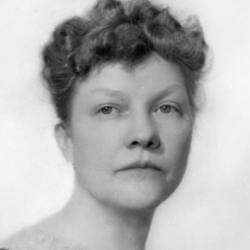Biography of a great Black American resurrected
Denver-born author Rackham Holt’s biography of George Washington Carver, 80th anniversary edition
Denver-born author Rackham Holt’s biography of George Washington Carver, 80th anniversary edition
George Washington Carver is a figure we learn about in school, generally as an African American agriculturist who developed peanuts into a cash crop and figured out how to do some interesting things with that crop. However, as impressive as those accomplishments we heard about in our childhoods are, Carver did so much more. A man of science—charismatic, creative, and highly adaptive—Carver was and is a fascinating figure, resurrected in 2023 for current generations to learn about in the 80th anniversary release of George Washington Carver: An American Biography, written by Rackham Holt in 1943, and re-released by Colorado Springs writer/publisher Sandra Knauf and her independent publishing company, Greenwoman Publishing.

Rackham Holt, 1949
Starting with foggy origins as the child of a slave, the book traces Carver’s journey from helping with outdoor work, like gardening and poultry, to learning “women’s work,” such as baking, cooking and cleaning. He was a sickly child, small for his age, and left with a stutter and speech impediment from whooping cough. From the beginning, he became fascinated with plant life and nature in all its glory. He loved birds and wanted to know their proper names, but the books he had access to didn’t teach this and during Reconstruction, education wasn’t something easily accessible to Black Americans, except in rare instances. Young George was good at a lot of things and one of those was seeking out education wherever he could, however he could. From solo exploration to finding schools open to ex-slaves to individuals who, charmed by the young boy (and eventually the man), took him in and taught him what they could, he gained as much knowledge as he could until he became the first African American student to attend Iowa State University.
Denver-born Holt (whose real name was Margaret Van Vechten Saunders) had to enlist help to convince Carver to work with her on the book, making this the only authorized biography of Carver. She was persistent and did an amazing job reaching out to people in Carver’s life. His was a life that had touched many, and he had a diverse array of friends who seemed eager to share tales of their interactions with the scientific genius. This ensured the book was well fleshed out and had information which Carver, a humble man, wouldn’t have shared about himself.
The book reads like a work of fiction, with a delicious flow that pulls the reader along, enthralled by the fairy tale telling. To be clear, this isn’t a fairy tale that focuses on only the good, but a true fairy tale, intertwining whimsy with hard truths. Holt’s writing is breathless and engaging. I enjoy nonfiction, but tend to read it more slowly than fiction. That wasn’t at all true with this book. The pages flew by.
Carver never knew his mother, but he learned what he could about her (Mrs. Carver, who he called Aunt, would burst into tears when asked about her). He was fascinated by plants and nature, though he wasn’t allowed to bring specimens inside. (An aside here: this made me all the more fond of young George, as I had to limit my daughter to a single “nature drawer” in her bureau, because she loved to collect bits of nature and bring them inside.) He was a natural learner, able to observe and quickly pick up how to do things. Leaving home at only ten-years-old, Carver charmed most people he met, no matter their skin color, learning from them, but also frequently educating them as well. He was known for being quiet, shy and respectful, but also highly intelligent, a hard worker starving for information. He was also known for his sense of humor, mimicking people and things in performances with his older brother. He made his way from Missouri to Kansas then Iowa, picking up skills and bits of knowledge at every stop, and eventually to Alabama where he taught at the Tuskegee Institute for over 40 years.
Holt broke down each of Carver’s brave moves, from leaving his home at age ten, to opening his own laundromat in his teen years, to proving himself repeatedly to people who originally looked down on him because of expectations based on skin color. His courage setting out as a child pales in comparison to his having done so at a time when slaves were beginning to be freed and former slave owners were enraged by that turn of events. Carver wasn’t viewed as human by many, and danger lay in wait for him around every corner. As a young boy, he witnessed the lynching of a Black man and fled immediately after.
Carver was a mix of labor and industry, art and exploration. The thing that really stood out was how earnest he was and how eager to help others, including poor white southerners. On his many journeys, he witnessed issues facing farmers and rural folks with a keen eye, foreseeing issues that would arise in the future. He strove to find workable solutions, inexpensive ways for them to change their lives. One of his missions was to ensure the south could become self-supporting again. Following the Civil War, the south  was plunged into poverty, its way of life changed (as it needed to be), and with only one means of economic support: cotton. But cotton ate away at the soil’s nutrients and left behind barren dirt and desperate farmers, not to mention boll weevils and just plain ignorance that kept farming from becoming sustainable. Carver discovered better ways to farm, taught rural folks how to grow their own food crops, introduced sweet potatoes and peanuts as flexible, nutritious and healthy crops, and shared his knowledge both nationwide and internationally, all without wanting anything back. In fact, he turned down potentially lucrative deals, not wanting to be paid just for information that helped others. Instead, he believed everyone should have access to healthy lives where they didn’t just labor all the time,but had leisure to explore the beauty of life. Carter painted and shared his love of beauty as art that also could have found success.
was plunged into poverty, its way of life changed (as it needed to be), and with only one means of economic support: cotton. But cotton ate away at the soil’s nutrients and left behind barren dirt and desperate farmers, not to mention boll weevils and just plain ignorance that kept farming from becoming sustainable. Carver discovered better ways to farm, taught rural folks how to grow their own food crops, introduced sweet potatoes and peanuts as flexible, nutritious and healthy crops, and shared his knowledge both nationwide and internationally, all without wanting anything back. In fact, he turned down potentially lucrative deals, not wanting to be paid just for information that helped others. Instead, he believed everyone should have access to healthy lives where they didn’t just labor all the time,but had leisure to explore the beauty of life. Carter painted and shared his love of beauty as art that also could have found success.
In his later years, equipped with a lab and space to work on his own, his time much in demand, Carver developed many uses for both sweet potatoes and peanuts, as well as other living things. He studied mycology, agriculture and plant life, and was able to identify anything people sent him. He developed a rare blue paint from clay, what would now be considered vegan meat produced from peanuts, peanut milk, health remedies from plants and much more, pre-dating the notion of heath food.
It is striking that George Washington Carver, a man with a slave owner’s names, grew to be an ambassador who changed the minds of many white people who looked down on Black people. He rooted himself in a country that hated him and others like him, and became determined to help not just his own people but also those who had previously been slave owners and would have been again if they could. He was good friends with both Booker T. Washington and Henry Ford who shared Carver’s fascination over the many uses of soybeans, a frequent topic of conversation among them. Carver was determined to raise his fellow ex-slaves to a place of education and self-sustaining skills and knowledge, but he held no ill will to those who wished him ill. He faced many injustices in his life, yet carried forward in his quiet, determined way.
It does need to be noted that, having been written in the 1940s, there is some problematic language that Knauf addresses in her introduction to the book. Holt’s language is never intended to lessen a great but humble man, and is instead a reflection of the time in which she wrote it.
This book should be the go-to biography of George Washington Carver. Between the depth of information and the obvious respect and fascination Holt had for him, combined with the delightful writing style of a single mother who’d faced hard times and wrote under a pen name, this is a wonderful piece of history. The book did well when it was originally released, translated into multiple languages and went to press repeatedly for 20 years. It faded into obscurity during the tumult of the 1960s, but is getting its second life now. The photographs included in the book bring an even better understanding of who Carver was, especially later in his life. There’s something so calming and yet interesting about him, even in still photos. His quiet confidence, born of knowledge, shows through, and the photos of him doing the things he loved—examining a plant, painting a picture—exude inner peace. He only wanted to do the things he loved and help others. Instead, he gained worldwide fame that held him back in some ways and, in other ways, gave him more opportunities to learn and to help people. By the time he died, Carver had earned the ears and eyes of world leaders and scientists, and the respect of those around him.
George Washington Carver: An American Biography by Rackham Holt (re-released by Sandra Knauf, Greenwoman Publishing) is a delightful and fascinating book about an amazing man who defied the odds of his birth, educated a populace, celebrated many firsts and engineered incredible scientific advances which he shared for free with anyone who would listen. Well written and historically important, this is a highly recommended read.
A fan of all things fantastical and frightening, Shannon Lawrence writes primarily horror and fantasy. Her short stories can be found in over 60 anthologies and magazines in addition to her horror short story collections. Her nonfiction title, The Business of Short Stories, and debut urban fantasy novel, Myth Stalker: Wendigo Nights, are available now. You can also find her as a co-host of the podcast Mysteries, Monsters, & Mayhem. When she's not writing, she's hiking through the wilds of Colorado and photographing her magnificent surroundings, where, coincidentally, there's always a place to hide a body or birth a monster. Find her at www.thewarriormuse.com.
Click here for more from Shannon Lawrence.

